TAXATION LAW: Deductions, GST, and Legal Expenditure Analysis
VerifiedAdded on 2019/11/20
|14
|2328
|276
Report
AI Summary
This report provides a detailed analysis of various aspects of taxation law. It begins by examining permissible deductions under Section 8-1 of the Income Tax Assessment Act 1997, addressing issues such as the moving costs of machinery, the impact of asset revaluation on insurance cover, and the deductibility of legal expenses related to winding-up petitions and solicitor fees. The report then delves into the determination of input tax credits for advertisement expenses under the GST Act 1999, referencing relevant rulings and case law to determine the eligibility of Big Bank Limited for claiming input tax credit. The report concludes with a comprehensive discussion of the relevant regulations, case laws, and their practical applications to the given scenarios, providing a thorough understanding of the key concepts in taxation law.
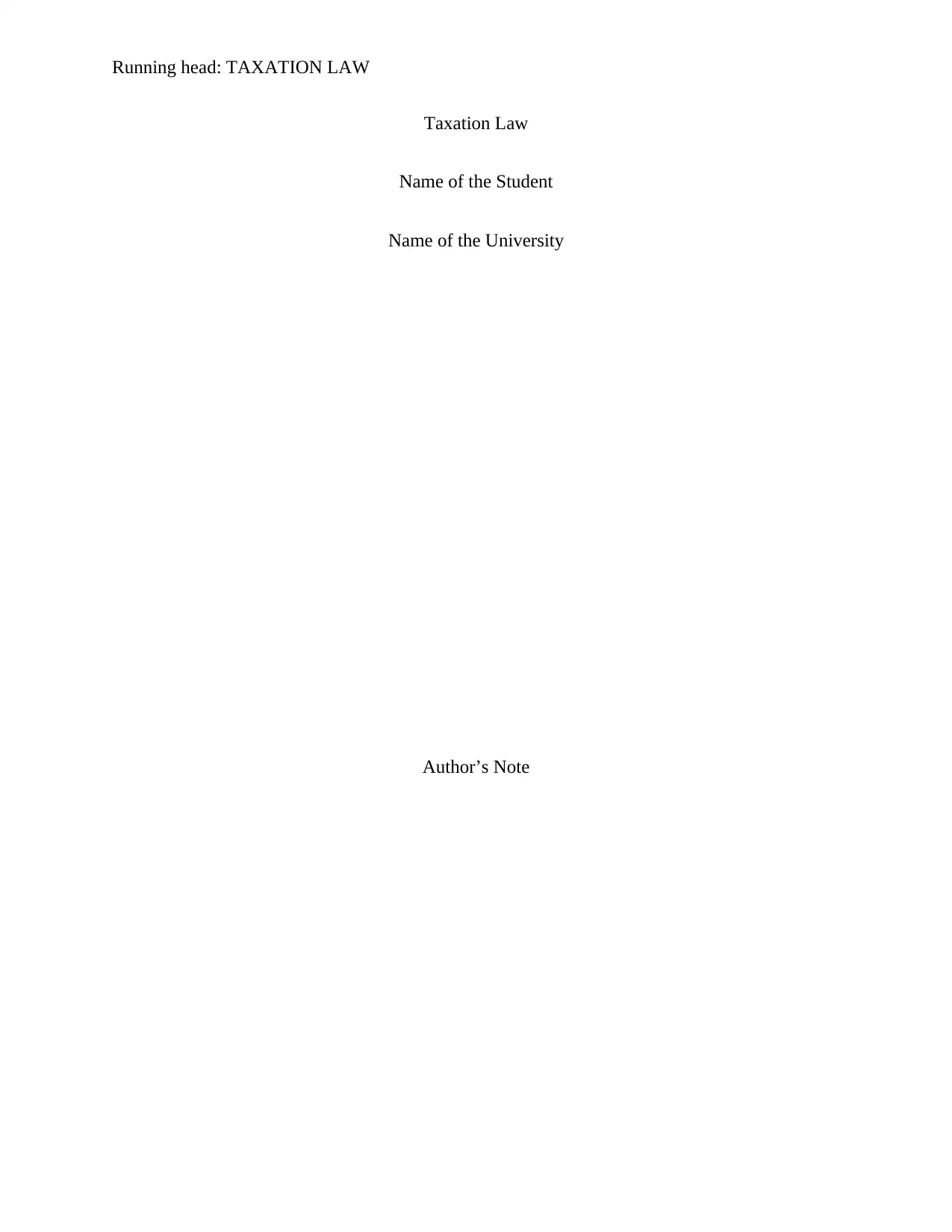
Running head: TAXATION LAW
Taxation Law
Name of the Student
Name of the University
Author’s Note
Taxation Law
Name of the Student
Name of the University
Author’s Note
Paraphrase This Document
Need a fresh take? Get an instant paraphrase of this document with our AI Paraphraser
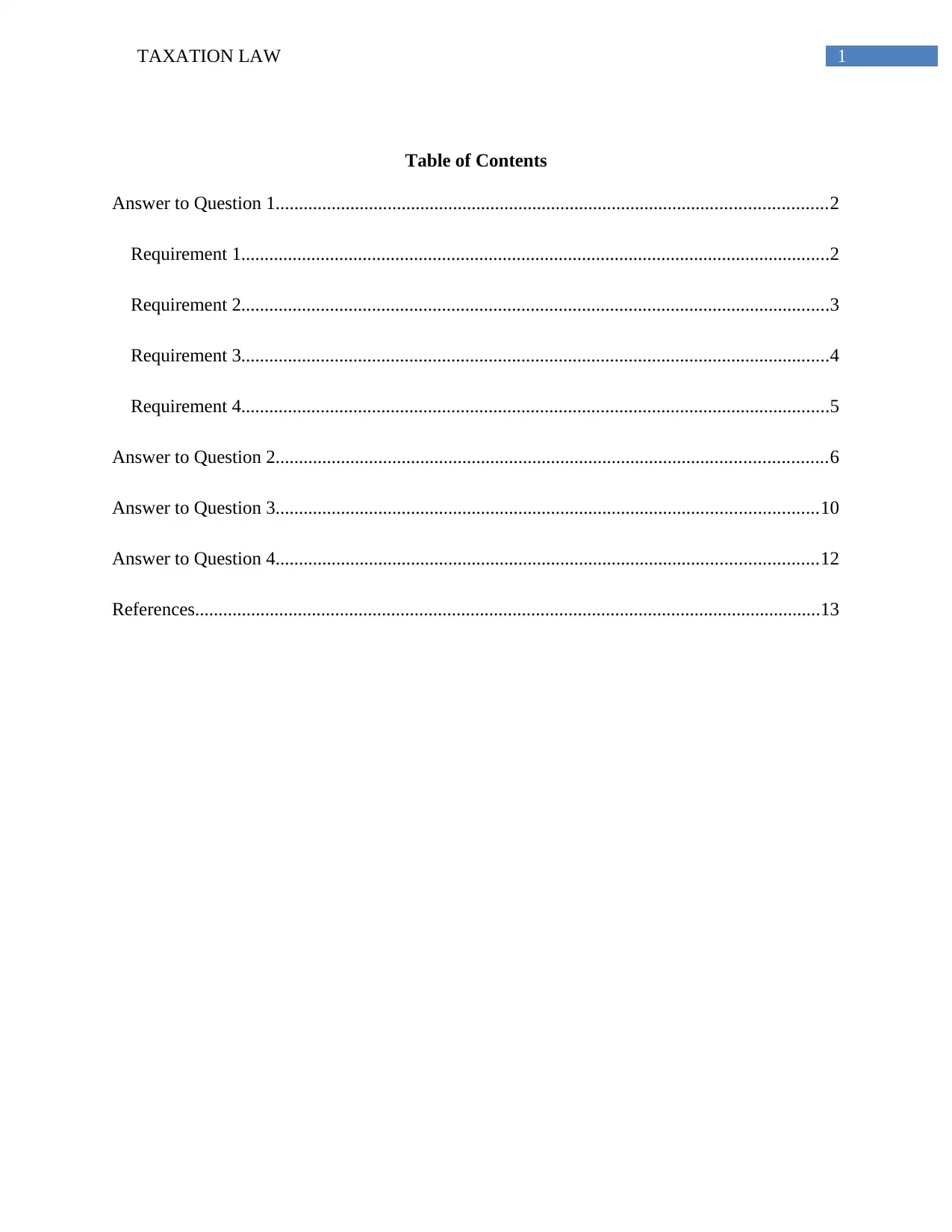
1TAXATION LAW
Table of Contents
Answer to Question 1......................................................................................................................2
Requirement 1..............................................................................................................................2
Requirement 2..............................................................................................................................3
Requirement 3..............................................................................................................................4
Requirement 4..............................................................................................................................5
Answer to Question 2......................................................................................................................6
Answer to Question 3....................................................................................................................10
Answer to Question 4....................................................................................................................12
References......................................................................................................................................13
Table of Contents
Answer to Question 1......................................................................................................................2
Requirement 1..............................................................................................................................2
Requirement 2..............................................................................................................................3
Requirement 3..............................................................................................................................4
Requirement 4..............................................................................................................................5
Answer to Question 2......................................................................................................................6
Answer to Question 3....................................................................................................................10
Answer to Question 4....................................................................................................................12
References......................................................................................................................................13
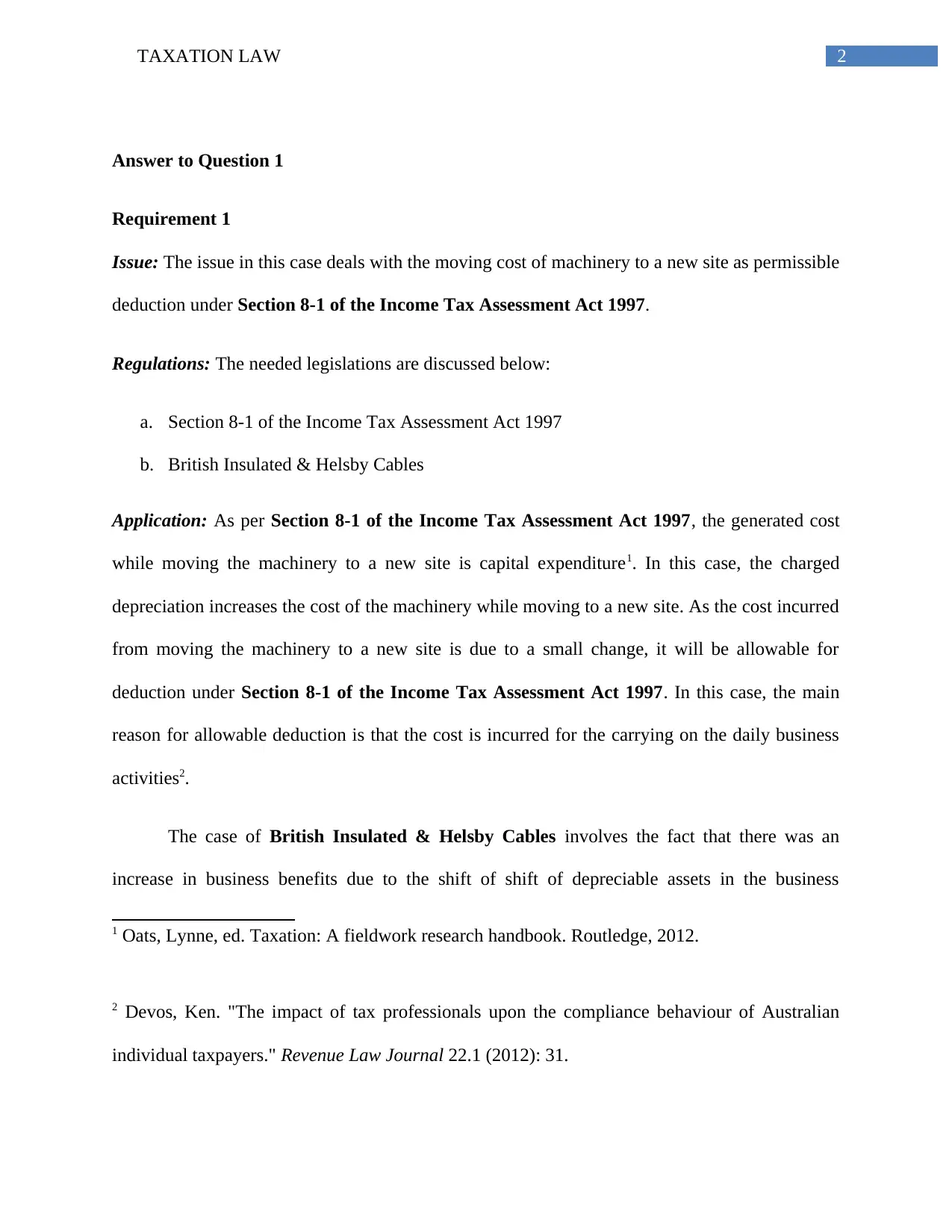
2TAXATION LAW
Answer to Question 1
Requirement 1
Issue: The issue in this case deals with the moving cost of machinery to a new site as permissible
deduction under Section 8-1 of the Income Tax Assessment Act 1997.
Regulations: The needed legislations are discussed below:
a. Section 8-1 of the Income Tax Assessment Act 1997
b. British Insulated & Helsby Cables
Application: As per Section 8-1 of the Income Tax Assessment Act 1997, the generated cost
while moving the machinery to a new site is capital expenditure1. In this case, the charged
depreciation increases the cost of the machinery while moving to a new site. As the cost incurred
from moving the machinery to a new site is due to a small change, it will be allowable for
deduction under Section 8-1 of the Income Tax Assessment Act 1997. In this case, the main
reason for allowable deduction is that the cost is incurred for the carrying on the daily business
activities2.
The case of British Insulated & Helsby Cables involves the fact that there was an
increase in business benefits due to the shift of shift of depreciable assets in the business
1 Oats, Lynne, ed. Taxation: A fieldwork research handbook. Routledge, 2012.
2 Devos, Ken. "The impact of tax professionals upon the compliance behaviour of Australian
individual taxpayers." Revenue Law Journal 22.1 (2012): 31.
Answer to Question 1
Requirement 1
Issue: The issue in this case deals with the moving cost of machinery to a new site as permissible
deduction under Section 8-1 of the Income Tax Assessment Act 1997.
Regulations: The needed legislations are discussed below:
a. Section 8-1 of the Income Tax Assessment Act 1997
b. British Insulated & Helsby Cables
Application: As per Section 8-1 of the Income Tax Assessment Act 1997, the generated cost
while moving the machinery to a new site is capital expenditure1. In this case, the charged
depreciation increases the cost of the machinery while moving to a new site. As the cost incurred
from moving the machinery to a new site is due to a small change, it will be allowable for
deduction under Section 8-1 of the Income Tax Assessment Act 1997. In this case, the main
reason for allowable deduction is that the cost is incurred for the carrying on the daily business
activities2.
The case of British Insulated & Helsby Cables involves the fact that there was an
increase in business benefits due to the shift of shift of depreciable assets in the business
1 Oats, Lynne, ed. Taxation: A fieldwork research handbook. Routledge, 2012.
2 Devos, Ken. "The impact of tax professionals upon the compliance behaviour of Australian
individual taxpayers." Revenue Law Journal 22.1 (2012): 31.
⊘ This is a preview!⊘
Do you want full access?
Subscribe today to unlock all pages.

Trusted by 1+ million students worldwide
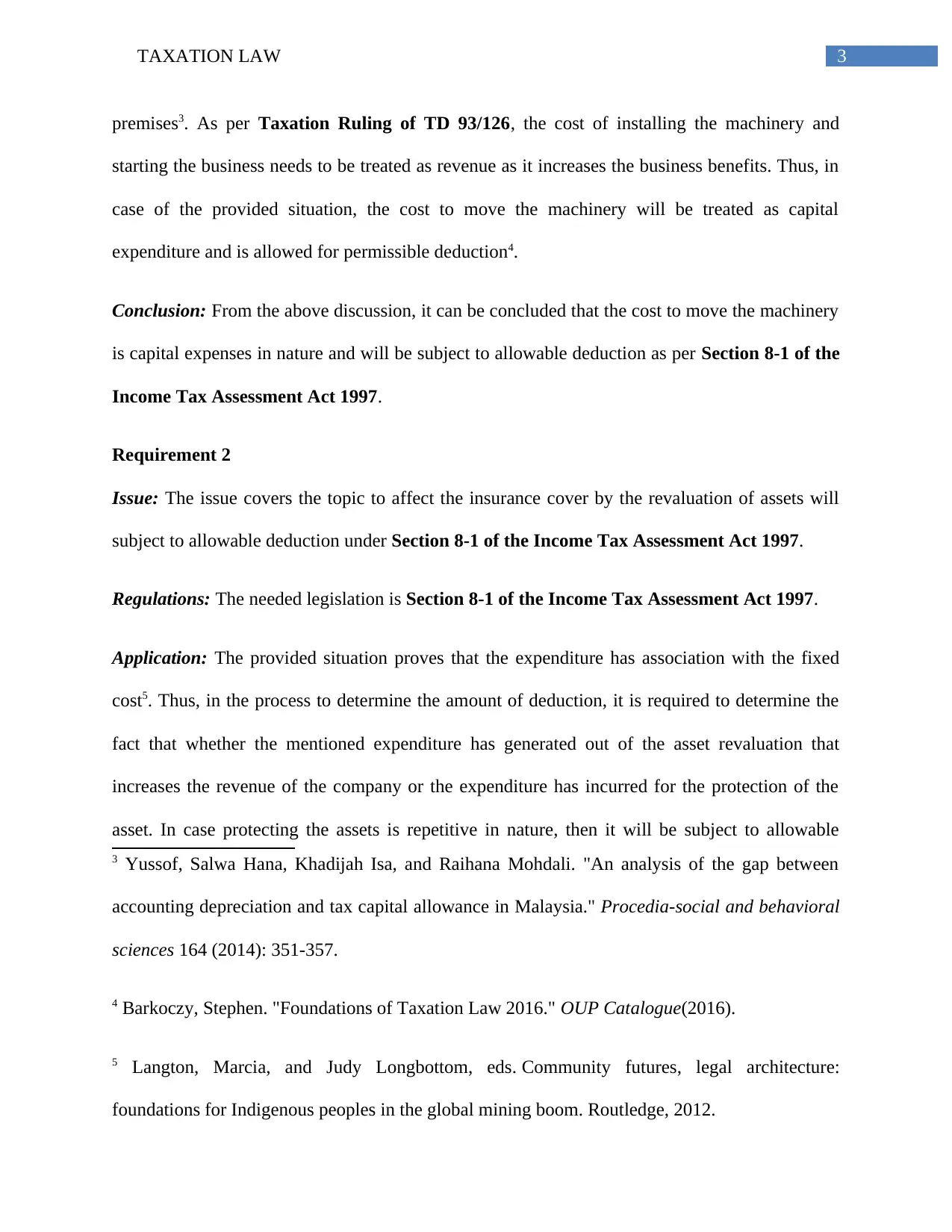
3TAXATION LAW
premises3. As per Taxation Ruling of TD 93/126, the cost of installing the machinery and
starting the business needs to be treated as revenue as it increases the business benefits. Thus, in
case of the provided situation, the cost to move the machinery will be treated as capital
expenditure and is allowed for permissible deduction4.
Conclusion: From the above discussion, it can be concluded that the cost to move the machinery
is capital expenses in nature and will be subject to allowable deduction as per Section 8-1 of the
Income Tax Assessment Act 1997.
Requirement 2
Issue: The issue covers the topic to affect the insurance cover by the revaluation of assets will
subject to allowable deduction under Section 8-1 of the Income Tax Assessment Act 1997.
Regulations: The needed legislation is Section 8-1 of the Income Tax Assessment Act 1997.
Application: The provided situation proves that the expenditure has association with the fixed
cost5. Thus, in the process to determine the amount of deduction, it is required to determine the
fact that whether the mentioned expenditure has generated out of the asset revaluation that
increases the revenue of the company or the expenditure has incurred for the protection of the
asset. In case protecting the assets is repetitive in nature, then it will be subject to allowable
3 Yussof, Salwa Hana, Khadijah Isa, and Raihana Mohdali. "An analysis of the gap between
accounting depreciation and tax capital allowance in Malaysia." Procedia-social and behavioral
sciences 164 (2014): 351-357.
4 Barkoczy, Stephen. "Foundations of Taxation Law 2016." OUP Catalogue(2016).
5 Langton, Marcia, and Judy Longbottom, eds. Community futures, legal architecture:
foundations for Indigenous peoples in the global mining boom. Routledge, 2012.
premises3. As per Taxation Ruling of TD 93/126, the cost of installing the machinery and
starting the business needs to be treated as revenue as it increases the business benefits. Thus, in
case of the provided situation, the cost to move the machinery will be treated as capital
expenditure and is allowed for permissible deduction4.
Conclusion: From the above discussion, it can be concluded that the cost to move the machinery
is capital expenses in nature and will be subject to allowable deduction as per Section 8-1 of the
Income Tax Assessment Act 1997.
Requirement 2
Issue: The issue covers the topic to affect the insurance cover by the revaluation of assets will
subject to allowable deduction under Section 8-1 of the Income Tax Assessment Act 1997.
Regulations: The needed legislation is Section 8-1 of the Income Tax Assessment Act 1997.
Application: The provided situation proves that the expenditure has association with the fixed
cost5. Thus, in the process to determine the amount of deduction, it is required to determine the
fact that whether the mentioned expenditure has generated out of the asset revaluation that
increases the revenue of the company or the expenditure has incurred for the protection of the
asset. In case protecting the assets is repetitive in nature, then it will be subject to allowable
3 Yussof, Salwa Hana, Khadijah Isa, and Raihana Mohdali. "An analysis of the gap between
accounting depreciation and tax capital allowance in Malaysia." Procedia-social and behavioral
sciences 164 (2014): 351-357.
4 Barkoczy, Stephen. "Foundations of Taxation Law 2016." OUP Catalogue(2016).
5 Langton, Marcia, and Judy Longbottom, eds. Community futures, legal architecture:
foundations for Indigenous peoples in the global mining boom. Routledge, 2012.
Paraphrase This Document
Need a fresh take? Get an instant paraphrase of this document with our AI Paraphraser
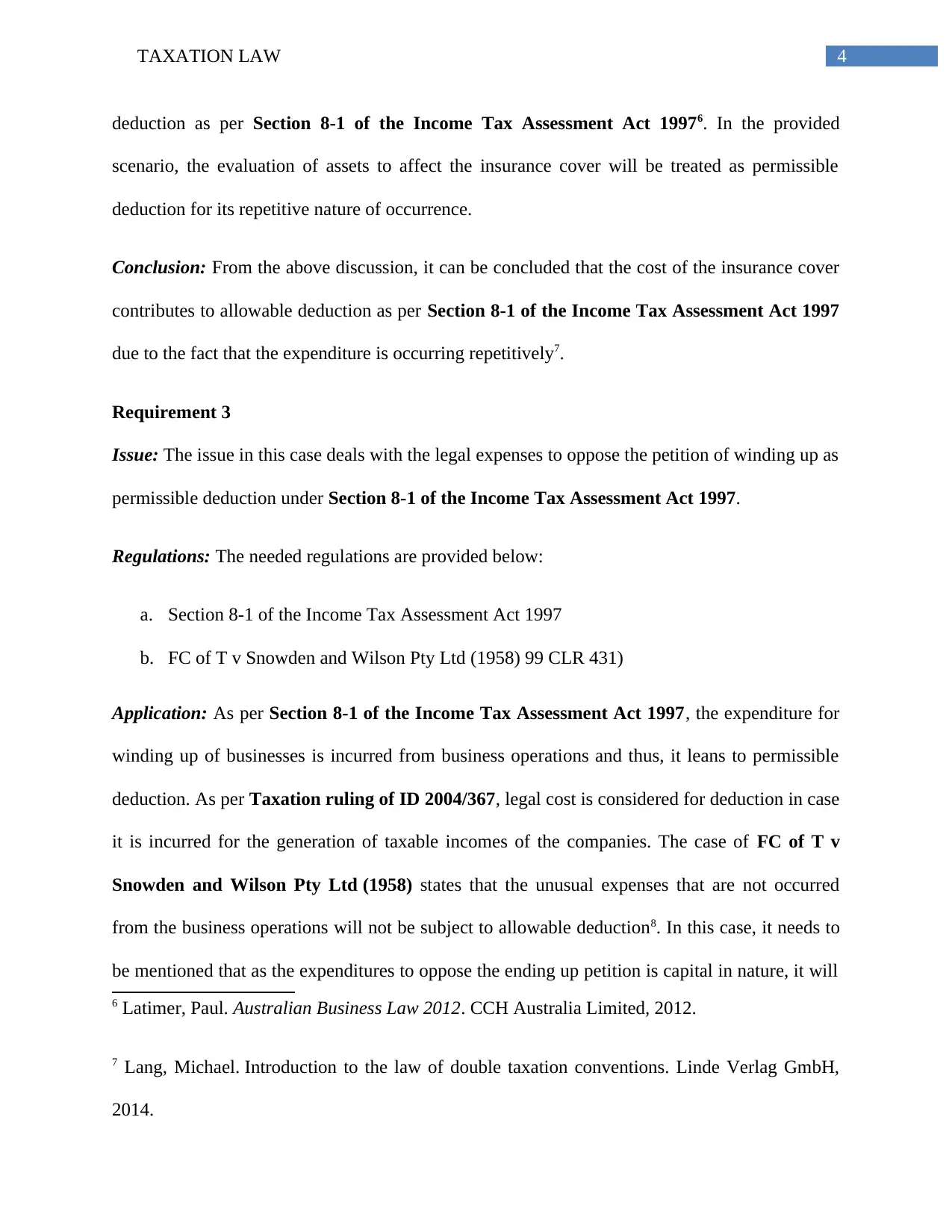
4TAXATION LAW
deduction as per Section 8-1 of the Income Tax Assessment Act 19976. In the provided
scenario, the evaluation of assets to affect the insurance cover will be treated as permissible
deduction for its repetitive nature of occurrence.
Conclusion: From the above discussion, it can be concluded that the cost of the insurance cover
contributes to allowable deduction as per Section 8-1 of the Income Tax Assessment Act 1997
due to the fact that the expenditure is occurring repetitively7.
Requirement 3
Issue: The issue in this case deals with the legal expenses to oppose the petition of winding up as
permissible deduction under Section 8-1 of the Income Tax Assessment Act 1997.
Regulations: The needed regulations are provided below:
a. Section 8-1 of the Income Tax Assessment Act 1997
b. FC of T v Snowden and Wilson Pty Ltd (1958) 99 CLR 431)
Application: As per Section 8-1 of the Income Tax Assessment Act 1997, the expenditure for
winding up of businesses is incurred from business operations and thus, it leans to permissible
deduction. As per Taxation ruling of ID 2004/367, legal cost is considered for deduction in case
it is incurred for the generation of taxable incomes of the companies. The case of FC of T v
Snowden and Wilson Pty Ltd (1958) states that the unusual expenses that are not occurred
from the business operations will not be subject to allowable deduction8. In this case, it needs to
be mentioned that as the expenditures to oppose the ending up petition is capital in nature, it will
6 Latimer, Paul. Australian Business Law 2012. CCH Australia Limited, 2012.
7 Lang, Michael. Introduction to the law of double taxation conventions. Linde Verlag GmbH,
2014.
deduction as per Section 8-1 of the Income Tax Assessment Act 19976. In the provided
scenario, the evaluation of assets to affect the insurance cover will be treated as permissible
deduction for its repetitive nature of occurrence.
Conclusion: From the above discussion, it can be concluded that the cost of the insurance cover
contributes to allowable deduction as per Section 8-1 of the Income Tax Assessment Act 1997
due to the fact that the expenditure is occurring repetitively7.
Requirement 3
Issue: The issue in this case deals with the legal expenses to oppose the petition of winding up as
permissible deduction under Section 8-1 of the Income Tax Assessment Act 1997.
Regulations: The needed regulations are provided below:
a. Section 8-1 of the Income Tax Assessment Act 1997
b. FC of T v Snowden and Wilson Pty Ltd (1958) 99 CLR 431)
Application: As per Section 8-1 of the Income Tax Assessment Act 1997, the expenditure for
winding up of businesses is incurred from business operations and thus, it leans to permissible
deduction. As per Taxation ruling of ID 2004/367, legal cost is considered for deduction in case
it is incurred for the generation of taxable incomes of the companies. The case of FC of T v
Snowden and Wilson Pty Ltd (1958) states that the unusual expenses that are not occurred
from the business operations will not be subject to allowable deduction8. In this case, it needs to
be mentioned that as the expenditures to oppose the ending up petition is capital in nature, it will
6 Latimer, Paul. Australian Business Law 2012. CCH Australia Limited, 2012.
7 Lang, Michael. Introduction to the law of double taxation conventions. Linde Verlag GmbH,
2014.
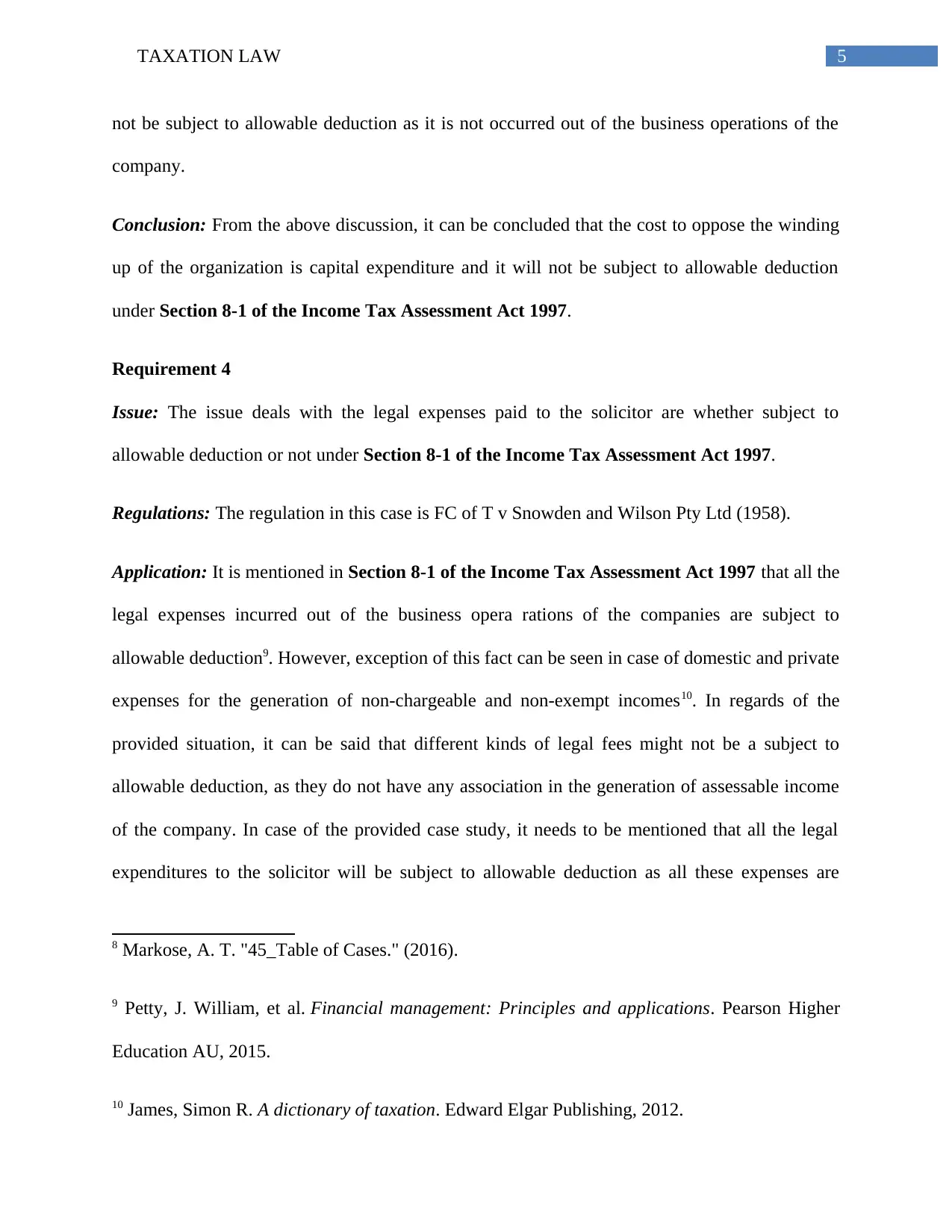
5TAXATION LAW
not be subject to allowable deduction as it is not occurred out of the business operations of the
company.
Conclusion: From the above discussion, it can be concluded that the cost to oppose the winding
up of the organization is capital expenditure and it will not be subject to allowable deduction
under Section 8-1 of the Income Tax Assessment Act 1997.
Requirement 4
Issue: The issue deals with the legal expenses paid to the solicitor are whether subject to
allowable deduction or not under Section 8-1 of the Income Tax Assessment Act 1997.
Regulations: The regulation in this case is FC of T v Snowden and Wilson Pty Ltd (1958).
Application: It is mentioned in Section 8-1 of the Income Tax Assessment Act 1997 that all the
legal expenses incurred out of the business opera rations of the companies are subject to
allowable deduction9. However, exception of this fact can be seen in case of domestic and private
expenses for the generation of non-chargeable and non-exempt incomes10. In regards of the
provided situation, it can be said that different kinds of legal fees might not be a subject to
allowable deduction, as they do not have any association in the generation of assessable income
of the company. In case of the provided case study, it needs to be mentioned that all the legal
expenditures to the solicitor will be subject to allowable deduction as all these expenses are
8 Markose, A. T. "45_Table of Cases." (2016).
9 Petty, J. William, et al. Financial management: Principles and applications. Pearson Higher
Education AU, 2015.
10 James, Simon R. A dictionary of taxation. Edward Elgar Publishing, 2012.
not be subject to allowable deduction as it is not occurred out of the business operations of the
company.
Conclusion: From the above discussion, it can be concluded that the cost to oppose the winding
up of the organization is capital expenditure and it will not be subject to allowable deduction
under Section 8-1 of the Income Tax Assessment Act 1997.
Requirement 4
Issue: The issue deals with the legal expenses paid to the solicitor are whether subject to
allowable deduction or not under Section 8-1 of the Income Tax Assessment Act 1997.
Regulations: The regulation in this case is FC of T v Snowden and Wilson Pty Ltd (1958).
Application: It is mentioned in Section 8-1 of the Income Tax Assessment Act 1997 that all the
legal expenses incurred out of the business opera rations of the companies are subject to
allowable deduction9. However, exception of this fact can be seen in case of domestic and private
expenses for the generation of non-chargeable and non-exempt incomes10. In regards of the
provided situation, it can be said that different kinds of legal fees might not be a subject to
allowable deduction, as they do not have any association in the generation of assessable income
of the company. In case of the provided case study, it needs to be mentioned that all the legal
expenditures to the solicitor will be subject to allowable deduction as all these expenses are
8 Markose, A. T. "45_Table of Cases." (2016).
9 Petty, J. William, et al. Financial management: Principles and applications. Pearson Higher
Education AU, 2015.
10 James, Simon R. A dictionary of taxation. Edward Elgar Publishing, 2012.
⊘ This is a preview!⊘
Do you want full access?
Subscribe today to unlock all pages.

Trusted by 1+ million students worldwide
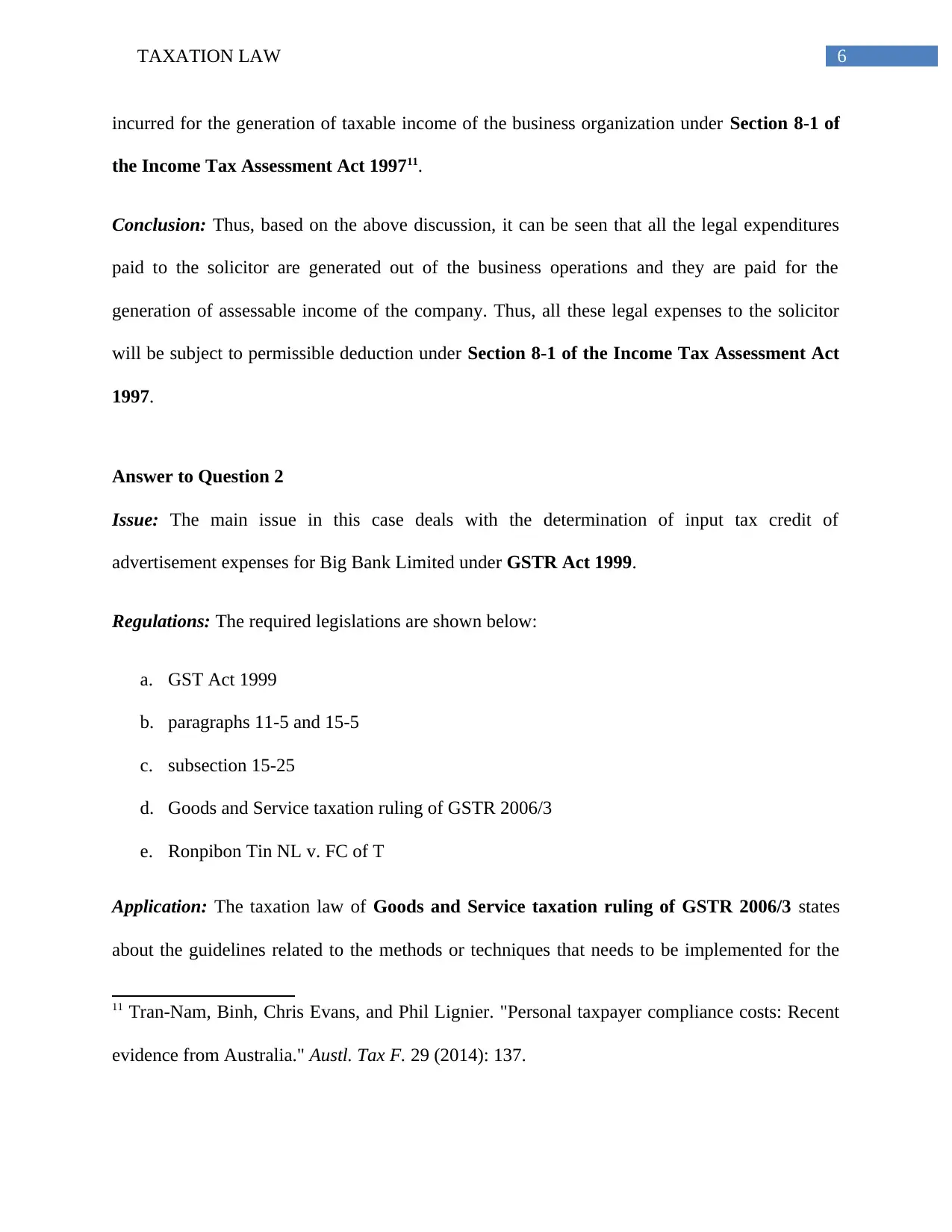
6TAXATION LAW
incurred for the generation of taxable income of the business organization under Section 8-1 of
the Income Tax Assessment Act 199711.
Conclusion: Thus, based on the above discussion, it can be seen that all the legal expenditures
paid to the solicitor are generated out of the business operations and they are paid for the
generation of assessable income of the company. Thus, all these legal expenses to the solicitor
will be subject to permissible deduction under Section 8-1 of the Income Tax Assessment Act
1997.
Answer to Question 2
Issue: The main issue in this case deals with the determination of input tax credit of
advertisement expenses for Big Bank Limited under GSTR Act 1999.
Regulations: The required legislations are shown below:
a. GST Act 1999
b. paragraphs 11-5 and 15-5
c. subsection 15-25
d. Goods and Service taxation ruling of GSTR 2006/3
e. Ronpibon Tin NL v. FC of T
Application: The taxation law of Goods and Service taxation ruling of GSTR 2006/3 states
about the guidelines related to the methods or techniques that needs to be implemented for the
11 Tran-Nam, Binh, Chris Evans, and Phil Lignier. "Personal taxpayer compliance costs: Recent
evidence from Australia." Austl. Tax F. 29 (2014): 137.
incurred for the generation of taxable income of the business organization under Section 8-1 of
the Income Tax Assessment Act 199711.
Conclusion: Thus, based on the above discussion, it can be seen that all the legal expenditures
paid to the solicitor are generated out of the business operations and they are paid for the
generation of assessable income of the company. Thus, all these legal expenses to the solicitor
will be subject to permissible deduction under Section 8-1 of the Income Tax Assessment Act
1997.
Answer to Question 2
Issue: The main issue in this case deals with the determination of input tax credit of
advertisement expenses for Big Bank Limited under GSTR Act 1999.
Regulations: The required legislations are shown below:
a. GST Act 1999
b. paragraphs 11-5 and 15-5
c. subsection 15-25
d. Goods and Service taxation ruling of GSTR 2006/3
e. Ronpibon Tin NL v. FC of T
Application: The taxation law of Goods and Service taxation ruling of GSTR 2006/3 states
about the guidelines related to the methods or techniques that needs to be implemented for the
11 Tran-Nam, Binh, Chris Evans, and Phil Lignier. "Personal taxpayer compliance costs: Recent
evidence from Australia." Austl. Tax F. 29 (2014): 137.
Paraphrase This Document
Need a fresh take? Get an instant paraphrase of this document with our AI Paraphraser
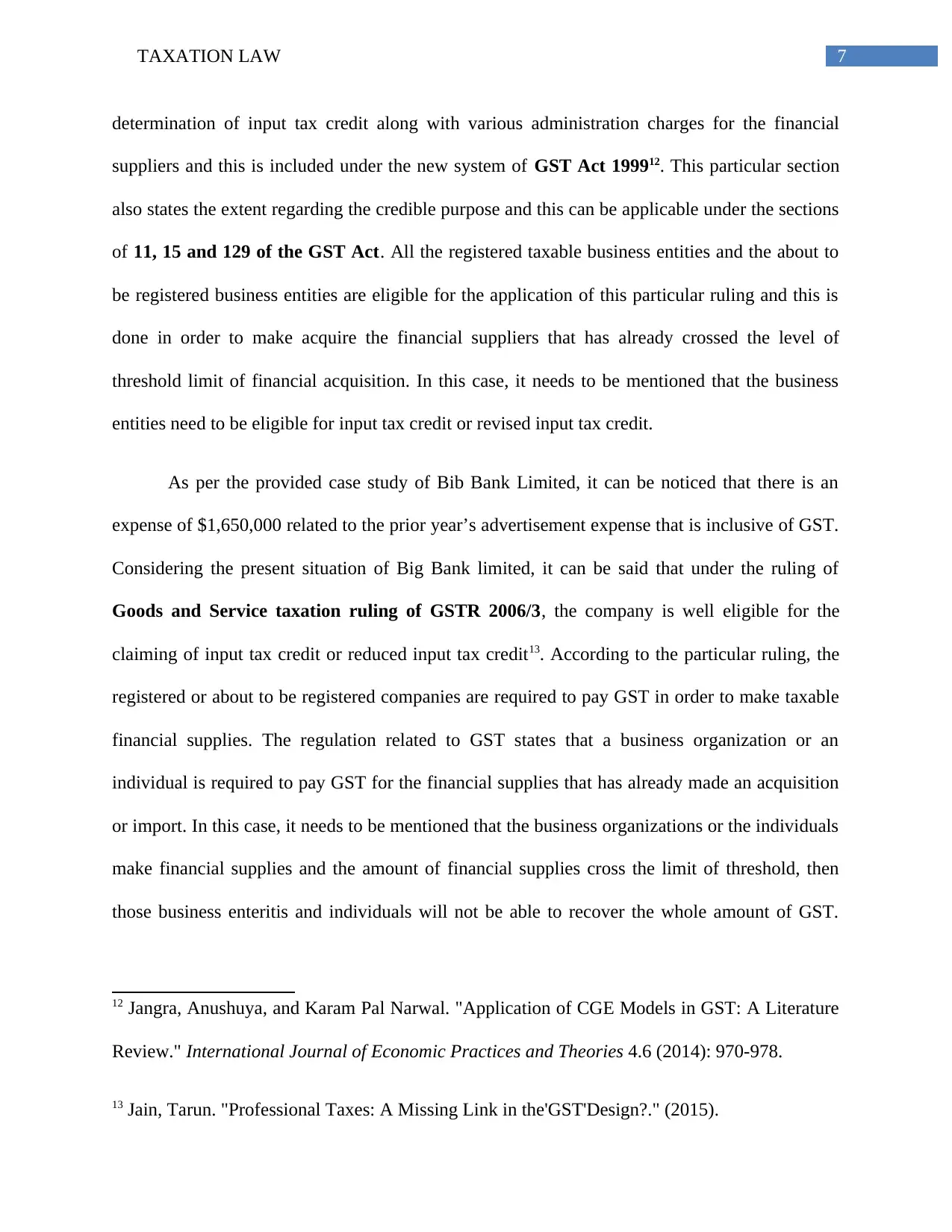
7TAXATION LAW
determination of input tax credit along with various administration charges for the financial
suppliers and this is included under the new system of GST Act 199912. This particular section
also states the extent regarding the credible purpose and this can be applicable under the sections
of 11, 15 and 129 of the GST Act. All the registered taxable business entities and the about to
be registered business entities are eligible for the application of this particular ruling and this is
done in order to make acquire the financial suppliers that has already crossed the level of
threshold limit of financial acquisition. In this case, it needs to be mentioned that the business
entities need to be eligible for input tax credit or revised input tax credit.
As per the provided case study of Bib Bank Limited, it can be noticed that there is an
expense of $1,650,000 related to the prior year’s advertisement expense that is inclusive of GST.
Considering the present situation of Big Bank limited, it can be said that under the ruling of
Goods and Service taxation ruling of GSTR 2006/3, the company is well eligible for the
claiming of input tax credit or reduced input tax credit13. According to the particular ruling, the
registered or about to be registered companies are required to pay GST in order to make taxable
financial supplies. The regulation related to GST states that a business organization or an
individual is required to pay GST for the financial supplies that has already made an acquisition
or import. In this case, it needs to be mentioned that the business organizations or the individuals
make financial supplies and the amount of financial supplies cross the limit of threshold, then
those business enteritis and individuals will not be able to recover the whole amount of GST.
12 Jangra, Anushuya, and Karam Pal Narwal. "Application of CGE Models in GST: A Literature
Review." International Journal of Economic Practices and Theories 4.6 (2014): 970-978.
13 Jain, Tarun. "Professional Taxes: A Missing Link in the'GST'Design?." (2015).
determination of input tax credit along with various administration charges for the financial
suppliers and this is included under the new system of GST Act 199912. This particular section
also states the extent regarding the credible purpose and this can be applicable under the sections
of 11, 15 and 129 of the GST Act. All the registered taxable business entities and the about to
be registered business entities are eligible for the application of this particular ruling and this is
done in order to make acquire the financial suppliers that has already crossed the level of
threshold limit of financial acquisition. In this case, it needs to be mentioned that the business
entities need to be eligible for input tax credit or revised input tax credit.
As per the provided case study of Bib Bank Limited, it can be noticed that there is an
expense of $1,650,000 related to the prior year’s advertisement expense that is inclusive of GST.
Considering the present situation of Big Bank limited, it can be said that under the ruling of
Goods and Service taxation ruling of GSTR 2006/3, the company is well eligible for the
claiming of input tax credit or reduced input tax credit13. According to the particular ruling, the
registered or about to be registered companies are required to pay GST in order to make taxable
financial supplies. The regulation related to GST states that a business organization or an
individual is required to pay GST for the financial supplies that has already made an acquisition
or import. In this case, it needs to be mentioned that the business organizations or the individuals
make financial supplies and the amount of financial supplies cross the limit of threshold, then
those business enteritis and individuals will not be able to recover the whole amount of GST.
12 Jangra, Anushuya, and Karam Pal Narwal. "Application of CGE Models in GST: A Literature
Review." International Journal of Economic Practices and Theories 4.6 (2014): 970-978.
13 Jain, Tarun. "Professional Taxes: A Missing Link in the'GST'Design?." (2015).
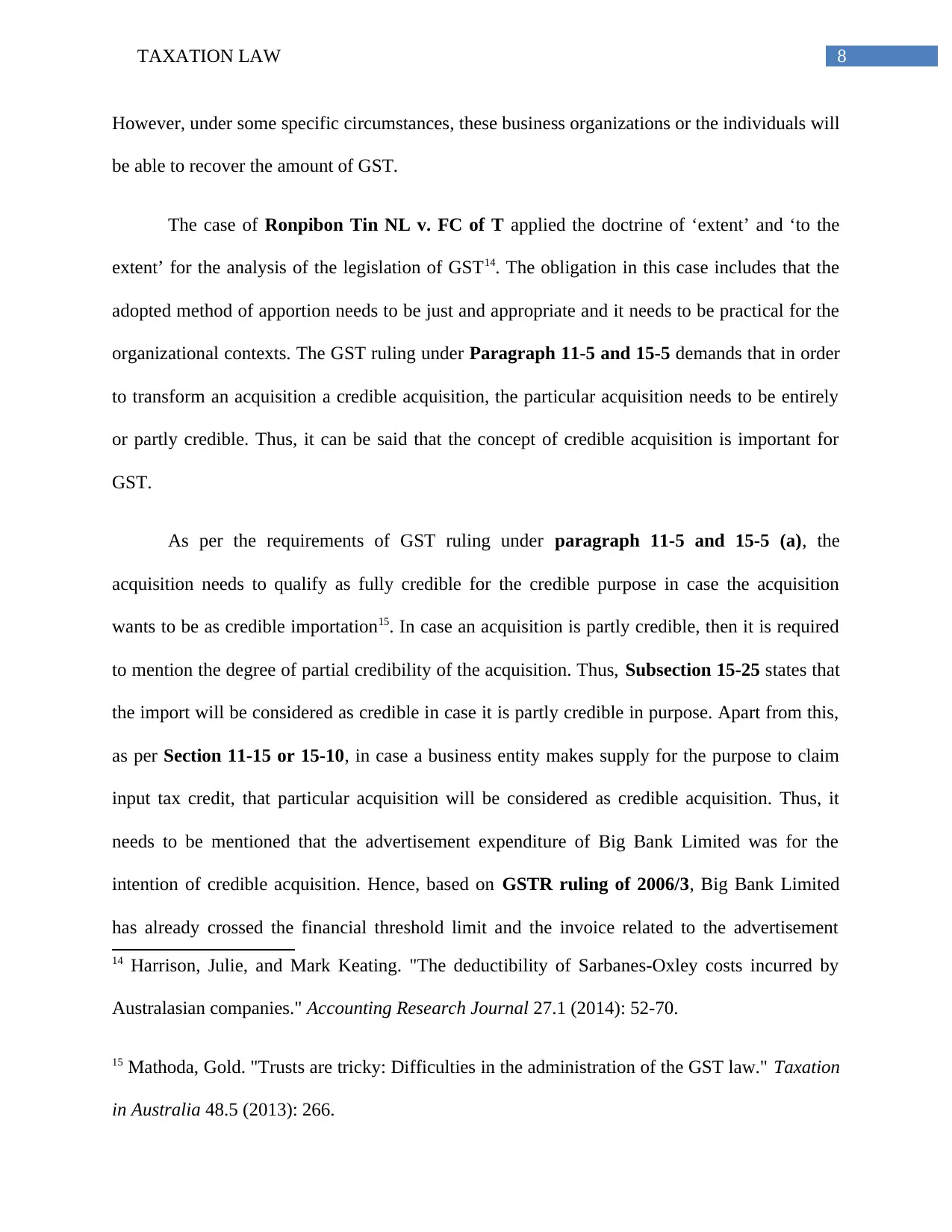
8TAXATION LAW
However, under some specific circumstances, these business organizations or the individuals will
be able to recover the amount of GST.
The case of Ronpibon Tin NL v. FC of T applied the doctrine of ‘extent’ and ‘to the
extent’ for the analysis of the legislation of GST14. The obligation in this case includes that the
adopted method of apportion needs to be just and appropriate and it needs to be practical for the
organizational contexts. The GST ruling under Paragraph 11-5 and 15-5 demands that in order
to transform an acquisition a credible acquisition, the particular acquisition needs to be entirely
or partly credible. Thus, it can be said that the concept of credible acquisition is important for
GST.
As per the requirements of GST ruling under paragraph 11-5 and 15-5 (a), the
acquisition needs to qualify as fully credible for the credible purpose in case the acquisition
wants to be as credible importation15. In case an acquisition is partly credible, then it is required
to mention the degree of partial credibility of the acquisition. Thus, Subsection 15-25 states that
the import will be considered as credible in case it is partly credible in purpose. Apart from this,
as per Section 11-15 or 15-10, in case a business entity makes supply for the purpose to claim
input tax credit, that particular acquisition will be considered as credible acquisition. Thus, it
needs to be mentioned that the advertisement expenditure of Big Bank Limited was for the
intention of credible acquisition. Hence, based on GSTR ruling of 2006/3, Big Bank Limited
has already crossed the financial threshold limit and the invoice related to the advertisement
14 Harrison, Julie, and Mark Keating. "The deductibility of Sarbanes-Oxley costs incurred by
Australasian companies." Accounting Research Journal 27.1 (2014): 52-70.
15 Mathoda, Gold. "Trusts are tricky: Difficulties in the administration of the GST law." Taxation
in Australia 48.5 (2013): 266.
However, under some specific circumstances, these business organizations or the individuals will
be able to recover the amount of GST.
The case of Ronpibon Tin NL v. FC of T applied the doctrine of ‘extent’ and ‘to the
extent’ for the analysis of the legislation of GST14. The obligation in this case includes that the
adopted method of apportion needs to be just and appropriate and it needs to be practical for the
organizational contexts. The GST ruling under Paragraph 11-5 and 15-5 demands that in order
to transform an acquisition a credible acquisition, the particular acquisition needs to be entirely
or partly credible. Thus, it can be said that the concept of credible acquisition is important for
GST.
As per the requirements of GST ruling under paragraph 11-5 and 15-5 (a), the
acquisition needs to qualify as fully credible for the credible purpose in case the acquisition
wants to be as credible importation15. In case an acquisition is partly credible, then it is required
to mention the degree of partial credibility of the acquisition. Thus, Subsection 15-25 states that
the import will be considered as credible in case it is partly credible in purpose. Apart from this,
as per Section 11-15 or 15-10, in case a business entity makes supply for the purpose to claim
input tax credit, that particular acquisition will be considered as credible acquisition. Thus, it
needs to be mentioned that the advertisement expenditure of Big Bank Limited was for the
intention of credible acquisition. Hence, based on GSTR ruling of 2006/3, Big Bank Limited
has already crossed the financial threshold limit and the invoice related to the advertisement
14 Harrison, Julie, and Mark Keating. "The deductibility of Sarbanes-Oxley costs incurred by
Australasian companies." Accounting Research Journal 27.1 (2014): 52-70.
15 Mathoda, Gold. "Trusts are tricky: Difficulties in the administration of the GST law." Taxation
in Australia 48.5 (2013): 266.
⊘ This is a preview!⊘
Do you want full access?
Subscribe today to unlock all pages.

Trusted by 1+ million students worldwide
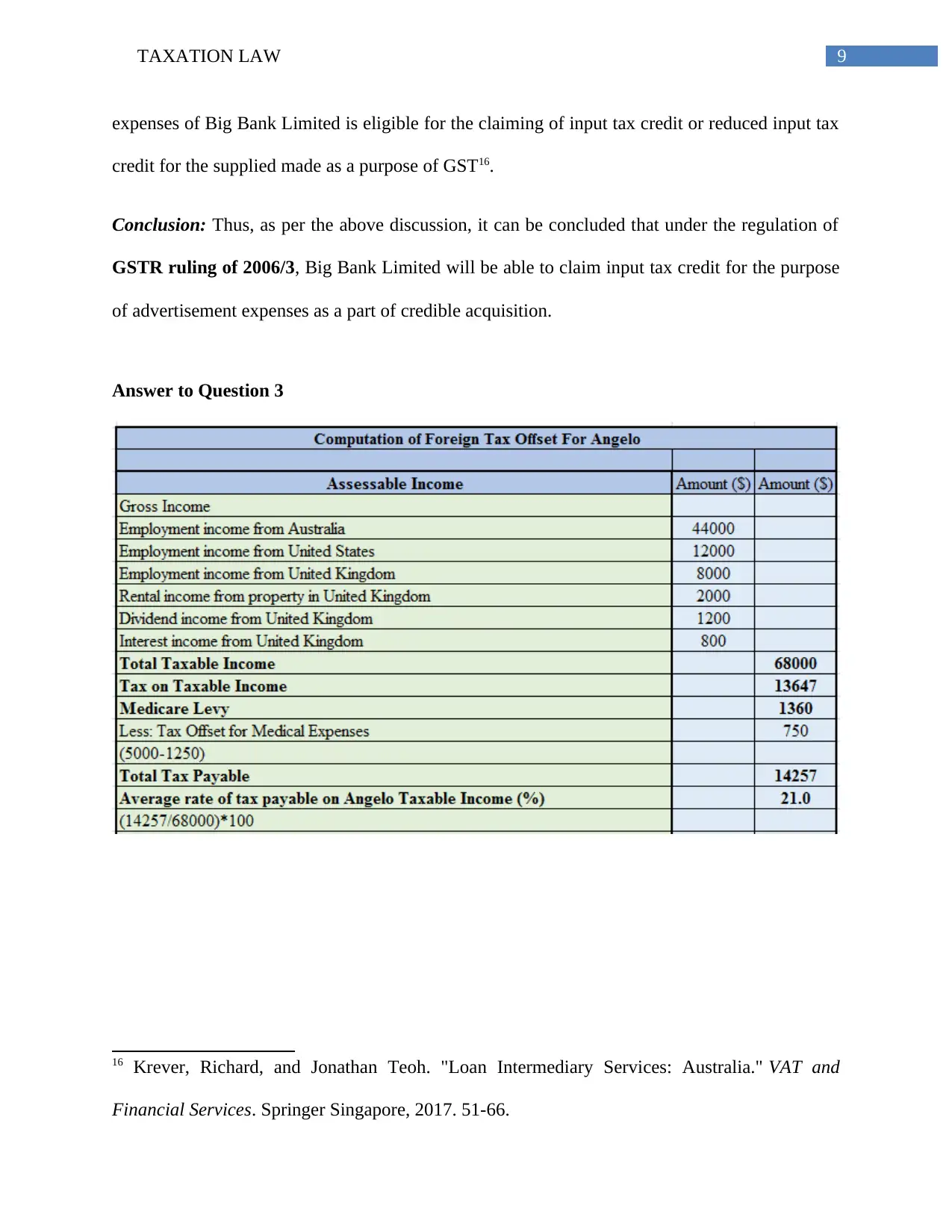
9TAXATION LAW
expenses of Big Bank Limited is eligible for the claiming of input tax credit or reduced input tax
credit for the supplied made as a purpose of GST16.
Conclusion: Thus, as per the above discussion, it can be concluded that under the regulation of
GSTR ruling of 2006/3, Big Bank Limited will be able to claim input tax credit for the purpose
of advertisement expenses as a part of credible acquisition.
Answer to Question 3
16 Krever, Richard, and Jonathan Teoh. "Loan Intermediary Services: Australia." VAT and
Financial Services. Springer Singapore, 2017. 51-66.
expenses of Big Bank Limited is eligible for the claiming of input tax credit or reduced input tax
credit for the supplied made as a purpose of GST16.
Conclusion: Thus, as per the above discussion, it can be concluded that under the regulation of
GSTR ruling of 2006/3, Big Bank Limited will be able to claim input tax credit for the purpose
of advertisement expenses as a part of credible acquisition.
Answer to Question 3
16 Krever, Richard, and Jonathan Teoh. "Loan Intermediary Services: Australia." VAT and
Financial Services. Springer Singapore, 2017. 51-66.
Paraphrase This Document
Need a fresh take? Get an instant paraphrase of this document with our AI Paraphraser
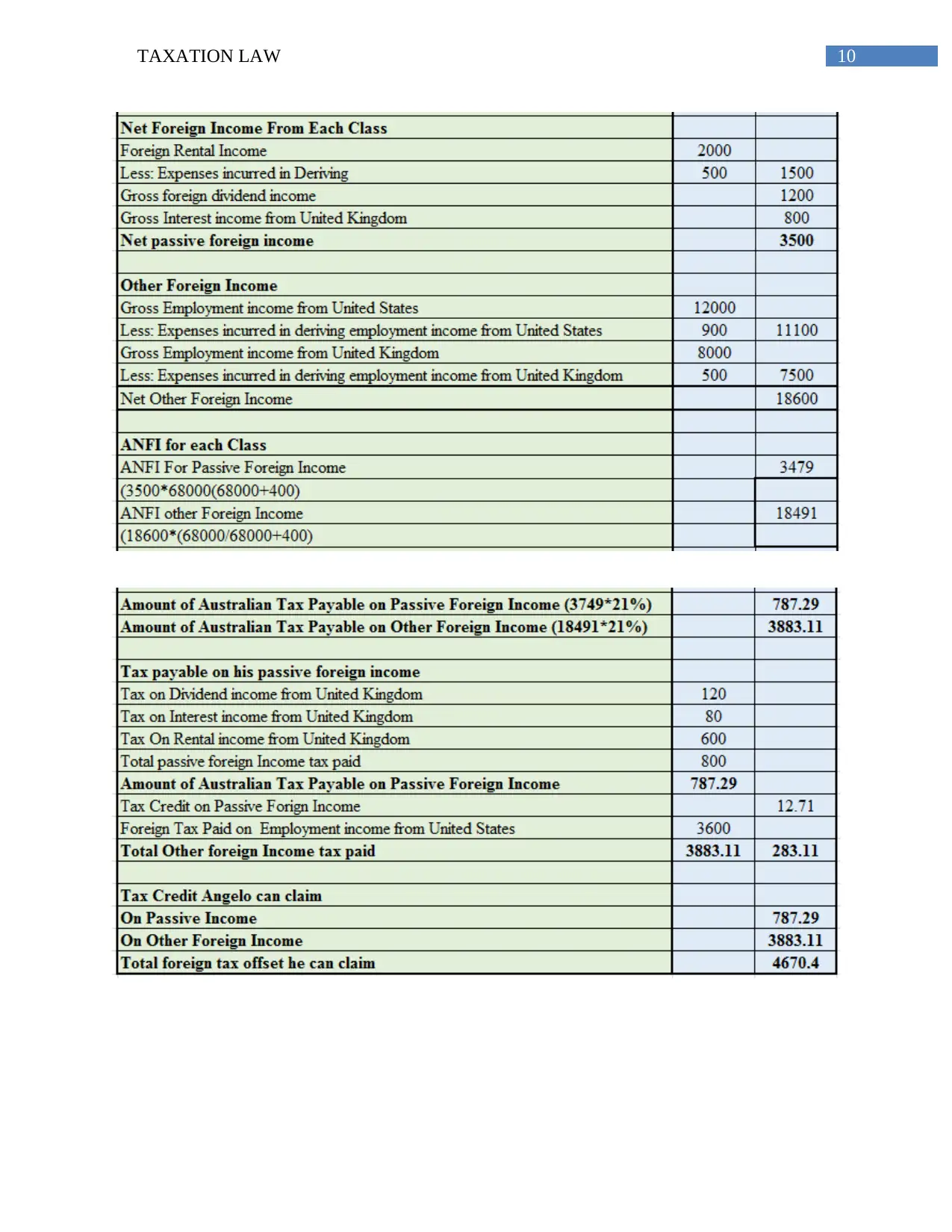
10TAXATION LAW
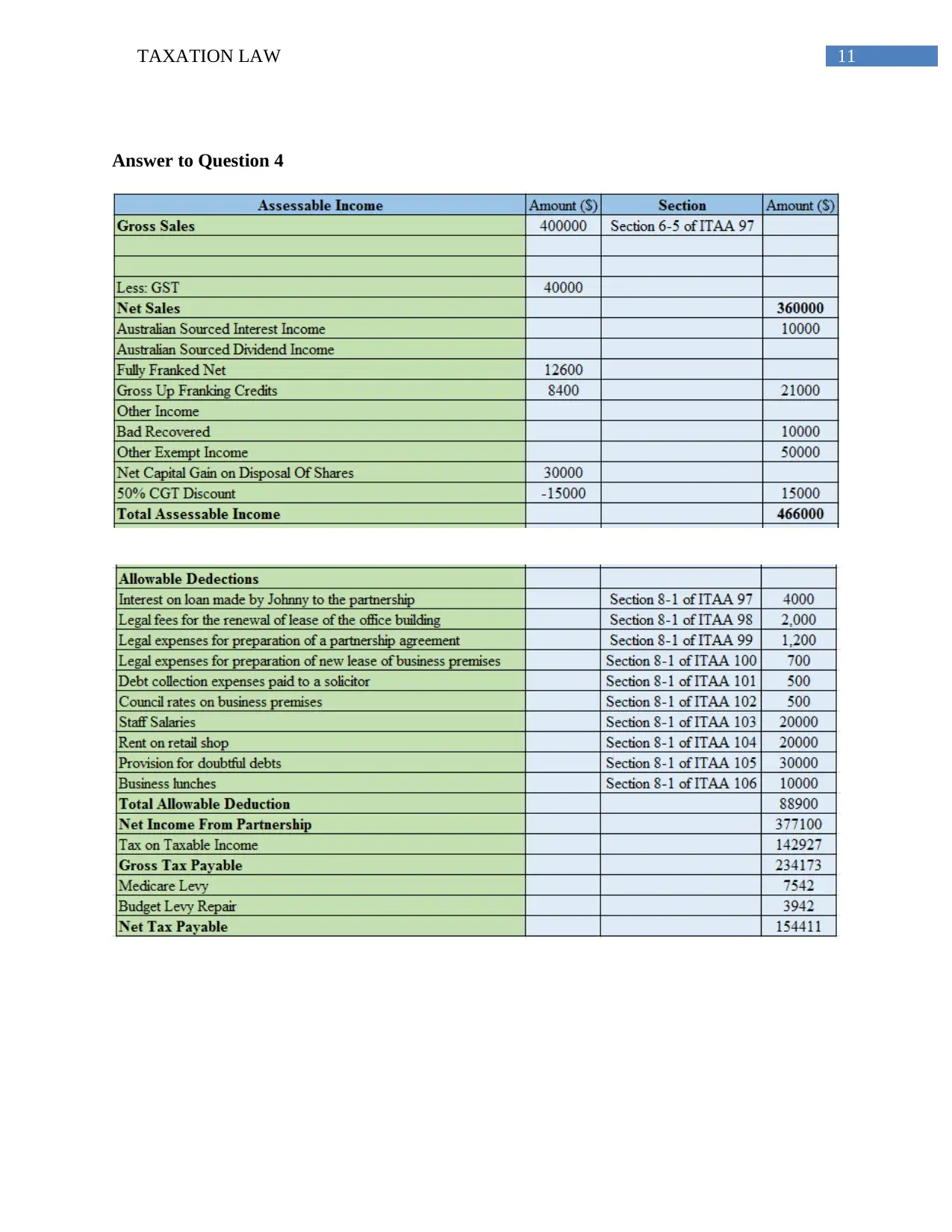
11TAXATION LAW
Answer to Question 4
Answer to Question 4
⊘ This is a preview!⊘
Do you want full access?
Subscribe today to unlock all pages.

Trusted by 1+ million students worldwide
1 out of 14
Related Documents
Your All-in-One AI-Powered Toolkit for Academic Success.
+13062052269
info@desklib.com
Available 24*7 on WhatsApp / Email
![[object Object]](/_next/static/media/star-bottom.7253800d.svg)
Unlock your academic potential
Copyright © 2020–2025 A2Z Services. All Rights Reserved. Developed and managed by ZUCOL.





